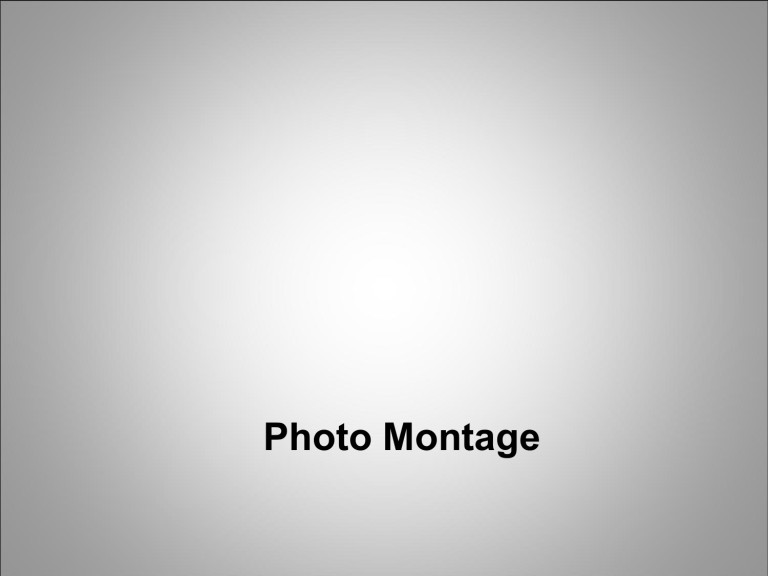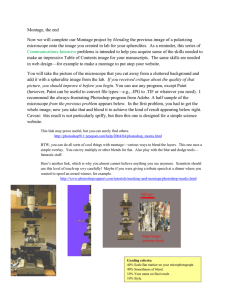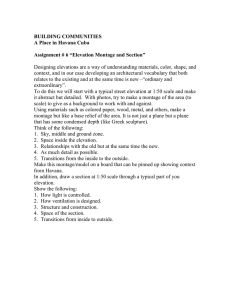
Photo Montage Lesson Objectives Aim: Use digital processes to combine images Objectives: • Define the meaning of image montage • Experiment with layers and/or digital cloning techniques to discover how to combine multiple image parts seamlessly to create a montage. • Review & reflect on production process (write an evaluation) and complete reflective log Montage is the technique where different images are combined to create a single new composition. Montage is similar to collage in which various image elements are stuck onto a single ground* * ‘ground’ is the term painters use for the surface of the canvas or other material which they paint on. A collage using photographs and paint. Richard Hamilton, Just what is it that makes today’s homes so different, so appealing? 1956 Henry Peach Robinson, Fading Away, 1858 Photographic montage is not a new technique Henry Peach Robinson used at least 5 black & white negatives to make his montage in 1858. Man Ray, A l'heure de lobservatoire Les amoureux, 1934 Before digital image manipulation, making a photographic montage required many hours of skilled work in the darkroom. Angus McBean, Photo montage, 1940 This press photograph purports to show actress Jane Fonda with politician John Kerry, speaking at an anti Vietnam war rally in the 1970’s. In fact the photograph is a montage of two separate images. What ethical issues does the use of image manipulation in news photographs, such as this montage raise? Photo montage has often been used by artists to express a political opinion or idea, as in the works here by John Hartfield. John Hartfield, Adolf the Superman, 1932 Montage is a useful narrative technique. By using several images, each with its own meaning, a more complex ‘story’ can often be told than by using a single image. To work out what Hannah Hock means in this montage … First deconstruct the image to identify the individual images – what are they of what is the title? Then try to think what each image might signify (stand for or mean) Finally, try to construct a narrative around the image, based on your above observations. Hannah Hock, High Finance, 1923 This montage was used as a ‘single’ cover by the band The Sex Pistols Sometimes a montage will utilise text within the image. Text can be helpful in directing or anchoring the meaning of an image. The title can also sometimes help us understand the artist’s intended meaning. What might the artist be trying to say about former Prime Minister Tony Blair? David Hockney, Mother 1, 1885 Artist David Hockney used photographs to create photo montages which he has termed joiners. Pablo Picasso, Dora Maar Seated, 1941 How might Hockney’s joiners have been inspired by Picasso & Cubism? Montage in Moving Images (TV & Movies) In film and television the term montage can have two different meanings: 1. The editing of various scenes so that they momentarily overlap, as in the fade down from one scene while simultaneously another scene fades up. 2. A type of editing in which lots of different scenes are shown one after another, but which all contribute to a unified or single meaning. For example, montage scenes in the Rocky films: http://www.youtube.com/watch?v=bu00RiPjaa4 Using Photoshop to create a Montage Open the images which you want to combine (to montage) Choose the magnetic lasso tool. Set: feather 3px Width = 3 px Contrast =10% Frequency = 99 Using the lasso tool, carefully go all the way around the head to select this area. You will see the “marching ants” around your selected area. Select the ‘Move’ tool and drag your selected area onto the other image. Tip: remember to press the TILE button to show both images. The OPACITY of the eraser is set here – try around 60% to start with. Select the eraser tool and use it to gently erase any background left around the edges of the moved image. Remember to erase the correct LAYER. Click on the layer which you want to work on – it will then be highlighted in blue. Tip: To show layers: WINDOW - LAYERS Tip: The Eraser and ANY tool size can be varied using the [ and ] keys. When you are happy with your image … LAYER – FLATTEN IMAGE SAVE AS … give it a suitable name and choose your memory stick for the save location Stretch … Try using FILTER - BLUR GAUSSIAN BLUR To blur the background layer Now experiment with your own images to produce at least one montage. Print out for mounting into your sketchbook. Lesson Objectives Aim: Use digital processes to combine images Objectives: • Define the meaning of image montage • Experiment with layers and/or digital cloning techniques to discover how to combine multiple image parts seamlessly to create a montage. • Review & reflect on production process (write an evaluation) and complete reflective log


